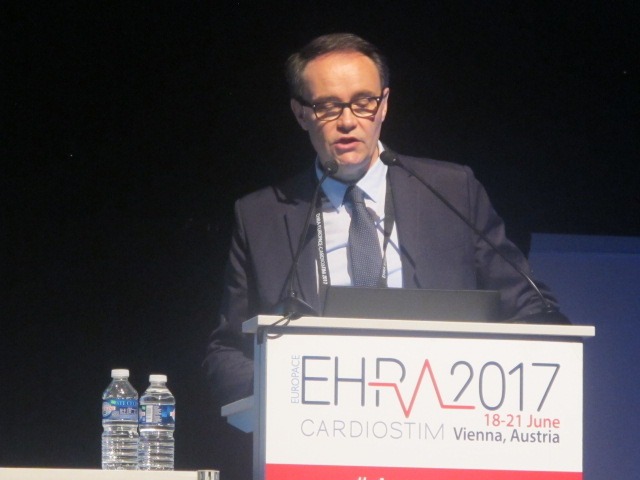
A French multicentre analysis of left atrial appendage (LAA) occlusion for stroke prevention in atrial fibrillation patients has found a 5.3% rate of thrombus formation on left atrial appendage occlusion devices. Authors of the study consider “this is not a benign finding and need to be better investigated since it was strongly associated with a higher risk of ischaemic stroke during follow-up.”
Laurent Fauchier (Université François Rabelais, Tours, France), author and presenter of the study at a Late-breaking trial session at EHRA-EUROPACE CARDIOSTIM (18‒21 June, Vienna, Austria), also highlighted that dual antiplatelet therapy (DAPT) at discharge may be associated with a lower risk of thrombus formation on device.
Transcatheter LAA occlusion is an alternative strategy for stroke prevention in atrial fibrillation patients, particularly those with contraindication to oral anticoagulation. “Thrombus formation on the device is a possible finding during follow-up in these patients, but the incidence and clinical significance is debated and poorly known,” Fauchier told delegates. Therefore, the aim of this study was to evaluate the incidence, predictors and prognosis of thrombus formation on LAA occlusion devices in patients with atrial fibrillation.
The independent study (industry did not support the study or had influence in the design, conduct and data analysis) enrolled 455 patients with atrial fibrillation and treated with LAA closure at eight French centres from February 2012 to December 2016. In total, 272 patients (57.7%) were implanted with Watchman (Boston Scientific) devices and 183 patients (38.4%) with Amplatzer (Abbott) devices.
Baseline characteristics were fairly similar between both groups. Median age in the Watchman group was 74.6±9.2 years (62.1% male) and 75.4±8.7 years in the Amplatzer group (61.9% male). Contraindication to oral anticoagulant use was found in 74.8% of patients in the Watchman group and 77.7% of patients in the Amplatzer group. Fauchier commented that the only difference noted was the antithrombotic management on each group. For instance, 14.9% of patients in the Amplatzer group had neither oral anticoagulant nor antiplatelet therapy at discharge compared with 3.4% in the Watchman group (<0.0001), and 18.5% of patients had oral anticoagulation but no antiplatelet therapy in the Amplatzer group compared with 37% in the Watchman group (<0.0001).
Fauchier highlighted that implanter physicians underwent training and a certification programme to ensure an appropriate level of expertise in order to minimise patient’s risk.
There were clinical visits, usually between one to three months post-procedure and follow-up visits at six, 12 and 24 months.
Thrombus detection on device was performed by 2D transesophageal echocardiography (TEE) or CT scan, most often between one and three months after LAA closure and at 12 months.
Fauchier reported that there were 100 major adverse events recorded after a follow-up of 11±11 months. Overall, there were 33 deaths (7.3%), 17 (3.8%) ischaemic strokes, 18 (4%) patients had a major haemorrhage and 24 (5.3%) patients had thrombus on the device (11 patients [6.1%] in the Amplatzer group and 13 patients [4.8%] in the Watchman group). “The thrombus formation outcome is slightly higher than what has been previously reported,” Fauchier noted.
“There were not many differences observed between the characteristics of the patients who presented with thrombus compared with no presence of thrombus during follow-up,” Fauchier said. The only relevant difference is that there was a lower rate of DAPT in patients with thrombus during follow-up (4.2%) compared with patients with no thrombus (24.8%), he commented.
Older age (p=0.035) and previous ischaemic stroke (p=0.002) were the two most relevant independent predictors of thrombus formation on device. “DAPT was a protective factor associated with lower risk on thrombus formation on the device (p=0.018),” Fauchier highlighted.
He continued: “The prognosis of thrombus formation on the device is a highly debated issue and we saw that after thrombus formation the patient has a higher risk of ischaemic stroke and transient ischaemic attack. In a univariate analysis, the logrank test was significant (p=0.04) and, in addition, adjusted on clinical characteristics and antithrombotic therapy, the hazard ratio was higher for a risk of stroke after a thrombus formation (Hazard ratio [HR] 8.20, 95%CI 1.73-38.94, p=0.008).”
The predictors of stroke and transient ischaemic attack during follow-up were vascular diseases (p=0.002) and thrombus on device (p=0.008).
Concluding his presentation, Fauchier called for the need of optimal strategies at the time of implantation and for postoperative antithrombotic management to reduce thrombus formation on device and to improve prognosis.








